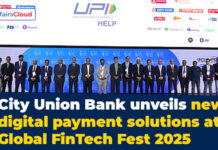![]() In September 2025, Prime Minister (PM) Narendra Modi inaugurated the 4th edition of SEMICON India at Yashobhoomi (India International Convention & Expo Centre) at New Delhi, Delhi.
In September 2025, Prime Minister (PM) Narendra Modi inaugurated the 4th edition of SEMICON India at Yashobhoomi (India International Convention & Expo Centre) at New Delhi, Delhi.
- The event was held, under the theme “Building the Next Semiconductor Powerhouse” from September 2 to 4, 2025.
Note: The previous editions were held in Bengaluru (Karnataka) (2022), Gandhinagar (Gujarat) (2023), and Greater Noida (2024).
Exam Hints:
- What? SEMICON India 2025
- Where? At Yashobhoomi in New Delhi (Delhi)
- Inaugurated by: PM Narendra Modi
- When? September 2 to 4, 2025
- Edition: 4th
- Organized by: ISM, MeitY, SEMI
- Highlight: Launch of Vikram-32
- Significance: 13 MoUs signed, Formation of IDTA
- Market Outlook: USD 38 Billion(2023) to USD100–110 Billion by 2030
Highlights of SEMICON India 2025:
Organizer: The event was jointly organized by the India Semiconductor Mission (ISM), Ministry of Electronics and Information Technology (MeitY), and Semiconductor Equipment and Materials International (SEMI), the global semiconductor industry association.
Participants: The event brought together over 350 exhibiting companies and participants from 48 countries and regions. Four country pavilions, 6 countries round tables and workforce development pavilion also participated. The event witnessed 35,000 registrations, 30,000 attendees and 25,000 online viewership.
Event:
Day 1 – Inauguration: Official launch of SEMICON India 2025.
Day 2 – Global Engagement: Exhibition visit, interactions with exhibitors, and a roundtable with global Chief Executive Officer(CEO)/ Chief Experience Officer / Chief officers(CXO) on India’s semiconductor potential.
Day 3 – Chip Design Focus: Panel discussions and keynotes centered on catalyzing India’s chip design ecosystem.
Launch of Vikram-32 Microprocessor:
First Made-in-India Chip: During the event, Union Minister Ashwini Vaishnaw, MeitY, Ministry of Railways (MoR), presented “Vikram-32”, India’s first indigenous 32-bit semiconductor microprocessor, to PM Narendra Modi, who called semiconductors the “digital diamonds” of the 21st century.
- He also showcased test chips from four government-approved semiconductor projects.
Resilience: Vikram-32, developed by Semiconductor Laboratory (SCL) of Indian Space Research Organization (ISRO), is designed to endure extreme environmental conditions during space missions, including temperatures ranging from -55 degree (°) Celsius (C) to +125 °C, making it suitable for launch vehicles, satellites, and rockets.
Predecessor: The Vikram-32 succeeds the 16-bit Vikram-1601 (used since 2009), upgrading to 32-bit architecture for faster computing, improved data handling, and modern software support.
Outcome of SEMICON India 2025:
At SEMICON India 2025, thirteen major announcements showcased India’s fast-track progress toward emerging as a global semiconductor powerhouse.
Launch of IDTA: Formation of the India Deep-Tech Investment Alliance (IDTA) announced, with an initial funding commitment of USD 1 million.
- It will provide funding and mentorship to deep-tech startups working in areas such as semiconductors, Artificial Intelligence (AI), Quantum technologies, Biotechnology, and space technology.
Tata Electronics: A Memorandum of Understanding (MoU) was signed between Tata Electronics Private Limited (TEPL) and Merck, a global leader in semiconductor materials and solutions, to strengthen the semiconductor fab at Dholera (Gujarat), ensuring supply chain, materials, and workforce development.
- TEPL signed an MoU with Centre for Development of Advanced Computing (C-DAC), under India’s Ministry of Electronics and Information Technology (MeitY), to boost the semiconductor design ecosystem, startups and Micro Small and Medium Enterprises (MSMEs) under Design-Linked Incentive (DLI) scheme and Chips-to-Startup Programme.
Kaynes Semicon: It has partnered with SPARSH-IQ, 3rdiTech, Focally, and SenseSemi Technologies to develop India’s first fully Indigenous automotive and industrial AI vision solution.
- It has signed an MoU with Infineon to launch India’s first “Made-in-India” Micro-Electro-Mechanical Systems (MEMS) microphone for wireless earbuds and wearables.
Larsen &Toubro(L&T) Semicon: It has signed an MoU with Indian Institute of Technology (IIT) Gandhinagar(Gujarat) & C-DAC to develop a Make-in-India secure chip with a smart Operating Systems (OS) for applications such as electronic (e)-passports, cryptographic products.
- It has also signed an MoU with Indian Institute of Science (IISc) Bengaluru(Karnataka) to establish India’s first National Innovation Hub for semiconductors and quantum technology.
ISM: India Semiconductor Mission (ISM) has signed an MoU with National Institute of Electronics and Information Technology (NIELIT) and Singapore Semiconductor Industry Association (SSIA) to enhance industry connectivity through lectures, hackathons, trainer programs, and innovation challenges.
- It has signed an MoU with New Age Makers Institute of Technology (NAMTECH) to design and deliver specialized programs in semiconductor manufacturing, automation, and AI, with industry placements.
- It has also signed an MoU with Arizona State University (ASU), United States of America(USA), for joint research, innovation, and workforce development.
Synopsys: C-DAC, Synopsys, and Indian Institute of Technology – Madras (IIT-M) (Tamil Nadu, TN) partnered to provide startups and MSMEs with access to Synopsys Ips via the ChipIN Centre.
Indisemic IoT: Indisemic, Gujarat based women-led startup, launched an Internet of Things (IoT) Development Board, powered by VEGA processor, developed by C-DAC. It will support applications in smart cities, drones, defence, healthcare drives, and industrial automation.
Key Announcements:
Modernization of SCL Mohali: Government of India (GoI) announced a comprehensive modernization program for the SCL in Mohali (Punjab) to enhance the production capacity, introduce advanced fabrication capabilities.
ISM 2.0: GoI unveiled India Semiconductor Mission 2.0(ISM 2.0) on the success of ISM 1.0, launched in 2021. It will cover Outsourced Semiconductor Assembly and Testing (OSAT) units, capital equipment, materials, and design tools.
Odisha: Government of Odisha signed an MoU with TopTrack Hi-Tech Printed Circuit Board (PCB) Private Limited (TopTrack Hi-Tech PCB) worth Rs.1005 Crores for advanced manufacturing of PCB.
- It has also signed an MoU worth Rs.1,650 crores with Sancode Technologies, in partnership with Silicon Connect, and Inari Amertron Berhad.
Semiconductor Market: India’s semiconductor industry is set for rapid expansion, with the market projected to grow from USD 38 billion in 2023 to between USD 100 billion and USD110 billion by 2030.
About Ministry of Electronics and Information Technology (MeitY):
Union Minister – Ashwini Vaishnaw (Rajya Sabha – Odisha)
Minister of State (MoS) – Jitin Prasada (Constituency – Pilibhit, Uttar Pradesh, UP)



